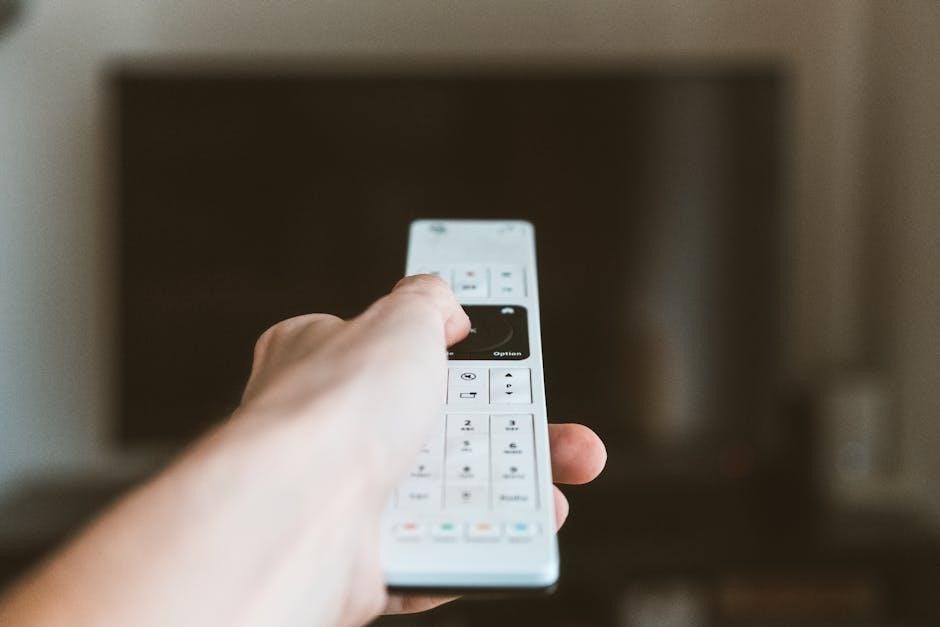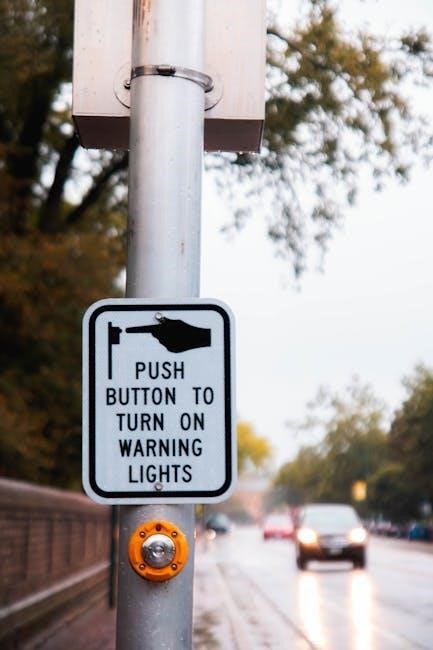Programming a Linear 3-button remote ensures seamless control of garage door openers and gates․ This guide provides step-by-step instructions for easy setup and reliable operation․
1․1 Overview of the Linear 3-Button Remote
The Linear 3-Button Remote is a versatile and user-friendly device designed for controlling garage door openers‚ gates‚ and other compatible systems․ It features three programmable buttons‚ each capable of sending a unique code to operate different devices․ The remote utilizes MegaCode technology for secure and reliable communication‚ ensuring interference-free operation․ An integrated LED indicator provides visual feedback during programming and operation‚ simplifying the setup process․ Compact and durable‚ the remote is powered by two AAA batteries‚ offering long-lasting performance․ Its intuitive design makes it easy to program and use‚ while its compatibility with Linear receivers ensures seamless integration into home automation systems․ This remote is an ideal solution for homeowners seeking convenient and secure control over their garage doors and gates․
1․2 Importance of Proper Programming
Proper programming of the Linear 3-Button Remote is essential for ensuring secure‚ efficient‚ and reliable operation․ It prevents unauthorized access to your garage door or gate‚ reducing security risks․ Correct programming guarantees compatibility with your specific device‚ such as garage door openers or gate operators‚ and ensures optimal signal strength․ Improper programming can lead to issues like weak signals‚ failed commands‚ or interference with other devices․ Accurate setup also ensures that all buttons function as intended‚ avoiding malfunctions or inconsistent performance․ By following the recommended programming steps‚ you can maintain long-term reliability and enjoy seamless control over your automated systems․ Proper programming is the foundation for trouble-free operation and peace of mind․

Understanding the Linear 3-Button Remote
The Linear 3-Button Remote is a user-friendly device designed for controlling garage doors‚ gates‚ and other compatible systems․ It features three programmable buttons‚ MegaCode technology‚ and an LED indicator for status feedback‚ ensuring reliable and secure operation․
2․1 Features of the Linear 3-Button Remote
The Linear 3-Button Remote is equipped with three programmable buttons‚ allowing users to control multiple devices such as garage doors‚ gates‚ and additional operators․ It utilizes MegaCode technology for secure and reliable communication between the remote and receiver․ The remote also features an LED indicator that provides visual feedback during programming and operation‚ such as flashing patterns to signal mode changes or successful synchronization․ Operating on a 318 MHz frequency‚ it offers a range of up to 300 feet‚ ensuring strong signal strength․ The remote is powered by two AAA alkaline batteries‚ which provide long-lasting performance․ Its compact design and user-friendly interface make it easy to use and program‚ while its compatibility with Linear receivers ensures seamless integration into home automation systems․
2․2 Button Functions and LED Feedback
The Linear 3-Button Remote features three distinct buttons‚ each designed for specific functions such as opening‚ closing‚ or stopping devices like garage doors or gates․ The LED indicator provides essential feedback‚ with different flash patterns indicating various states․ A steady LED light confirms successful synchronization with the receiver‚ while a slow flash signals standby mode․ Rapid flashing indicates active programming‚ guiding users through the setup process․ If the LED does not flash‚ it may indicate low battery or no signal reception․ Understanding these patterns is crucial for effective operation and troubleshooting․ The buttons are programmable‚ allowing users to assign functions based on their needs․ The LED feedback ensures clear communication between the remote and the receiver‚ simplifying the user experience and ensuring reliable performance․

Preparing for Programming
Installing batteries‚ ensuring device compatibility‚ and locating the receiver are essential steps to prepare for programming the Linear 3-Button Remote successfully․
3․1 Installing Batteries in the Remote
Proper battery installation is crucial for the Linear 3-Button Remote to function correctly․ Open the battery compartment and insert two AAA 1․5V alkaline batteries‚ ensuring correct polarity․ Avoid using damaged batteries‚ as they may cause malfunctions․ Secure the compartment tightly to maintain connectivity․ Refer to the user manual for specific battery requirements․ If the LED flashes weakly or the remote responds sluggishly‚ replace the batteries promptly․ Proper installation ensures reliable operation and optimal performance of the remote control․ Always use high-quality batteries to prevent signal interference or weak transmission․ This step is essential before proceeding with the programming process․

3․2 Ensuring Compatibility with Your Device
Before programming‚ verify that your Linear 3-Button Remote is compatible with your device․ Check the user manual or manufacturer’s specifications to confirm the remote uses the correct frequency and coding technology‚ such as MegaCode‚ for your receiver․ If unsure‚ consult the receiver’s documentation or contact the manufacturer․ Compatibility is essential for successful programming and operation․ Always use the correct remote model for your specific device to avoid functionality issues․ Proper alignment ensures reliable performance․ If the remote and receiver are not compatible‚ programming will not work‚ and you may need to purchase a suitable replacement․ Ensure your device supports the remote’s frequency‚ typically 318 MHz‚ for optimal signal transmission and control․
3․3 Locating the Receiver or Device
Locating the receiver or device is a critical step in programming your Linear 3-Button Remote․ Typically‚ the receiver is installed near the device it controls‚ such as a garage door opener or gate operator․ Ensure the receiver is accessible and in “Learn Mode” during programming․ Refer to your installation manual or manufacturer’s guide for precise location details․ A clear line of sight between the remote and receiver is essential for reliable signal transmission․ Position the receiver centrally to optimize performance․ If the receiver is hidden or obstructed‚ programming may fail or signal strength may weaken․ Always verify the receiver’s location before initiating the programming process to ensure a smooth and successful setup․

Step-by-Step Programming Instructions
Press and hold Button 1‚ then press Button 2 four times․ Release both buttons․ The LED will flash‚ indicating Learn Mode․ Activate the receiver and transmit the code․
4․1 Initiating Programming Mode
To begin programming‚ press and hold Button 1 on the remote․ While holding Button 1‚ press Button 2 four times in rapid succession․ Release both buttons․ The LED will flash quickly‚ indicating the remote is in Learn Mode․ This sequence prepares the remote to transmit its unique code to the receiver․ Ensure the receiver is activated and ready to accept the new code during this process․ The LED provides visual confirmation of successful code transmission․ If the LED does not flash‚ repeat the button sequence․ The LED’s flashing pattern is crucial for confirming the remote’s readiness․ Always monitor the LED during this step to ensure proper setup․
4․2 Pressing the Button Sequence
Press and hold Button 1 on the remote‚ then press Button 2 four times in rapid succession․ Release both buttons to complete the sequence․ This action sends a unique code to the receiver‚ initiating the programming process․ Ensure the sequence is performed quickly and accurately to avoid errors․ The button sequence is critical for syncing the remote with the receiver․ Each press must be firm and deliberate․ If the sequence is not recognized‚ repeat the process‚ ensuring the remote is in Learn Mode․ The button sequence is the foundation of the programming process‚ enabling the remote to communicate with the receiver effectively․ Always follow the sequence precisely for successful programming․ The button presses must be timed correctly to ensure proper code transmission․ This step is essential for establishing a connection between the remote and the device it controls․
4․3 Observing LED Feedback
During the programming process‚ the LED on the remote provides crucial feedback․ A slow flash indicates standby mode‚ while a rapid flash signals active programming․ When the LED lights steadily‚ it confirms successful synchronization with the receiver․ If the LED does not flash‚ it may indicate low battery or no signal reception․ Understanding these patterns is essential for troubleshooting and ensuring proper communication between the remote and the device it controls․ Always monitor the LED during programming to confirm the process․ The LED’s behavior is key to confirming successful programming․ Use the LED’s signals to guide the process and ensure proper setup․ The LED’s feedback is vital for verifying the remote’s status and ensuring reliable operation․
4․4 Finalizing the Programming Process
After completing the button sequence and observing the LED feedback‚ ensure the LED lights steadily‚ confirming successful synchronization․ Test the remote to verify all buttons function correctly with the receiver․ If the LED does not stop flashing‚ repeat the button sequence and check the receiver’s Learn Mode․ Once confirmed‚ the programming is complete‚ and the remote is ready for use․

The Role of the LED Indicator

The LED indicator provides critical feedback during programming‚ showing standby‚ active programming‚ and successful synchronization․ It helps troubleshoot issues and confirms proper communication with the receiver․
5․1 Understanding LED Flash Patterns
The LED indicator on the Linear 3-Button Remote uses distinct flash patterns to communicate its status․ A slow flash indicates standby mode‚ while a rapid flash signals active programming․ When the LED lights steadily‚ it confirms successful synchronization with the receiver․ If the LED does not flash at all‚ it may indicate low battery or no signal reception․ Additionally‚ a double flash can confirm that the receiver has accepted the remote’s code․ Understanding these patterns is crucial for troubleshooting and ensuring proper communication between the remote and the device; The LED’s behavior provides clear visual feedback‚ guiding you through the programming process and helping identify issues like weak signals or coding errors․ Monitoring the LED closely ensures accurate and successful programming every time․
5․2 Troubleshooting with LED Feedback
The LED indicator on the Linear 3-Button Remote is a valuable tool for diagnosing and resolving issues․ If the LED does not flash during programming‚ it may indicate low battery or no signal reception․ A slow flash suggests the remote is in standby mode‚ while a rapid flash indicates active programming․ If the LED flashes erratically or not at all‚ it could signal a button malfunction or compatibility problem․ By observing the LED’s behavior‚ you can identify issues such as weak signals‚ incorrect button sequences‚ or coding errors․ The LED’s feedback helps you pinpoint problems and guide the troubleshooting process․ For example‚ if the LED does not light up after pressing buttons‚ check the battery or alignment with the receiver․ This visual feedback system ensures efficient resolution of common issues‚ helping you restore functionality quickly and effectively․

Troubleshooting Common Issues
Common issues include weak signals‚ button malfunctions‚ or compatibility problems․ The LED provides feedback to diagnose these problems‚ ensuring quick resolution and optimal remote functionality․
6․1 Addressing Weak or No Signal
A weak or no signal issue with your Linear 3-button remote can stem from low battery strength‚ physical obstructions‚ or distance from the receiver․ Ensure batteries are fresh and properly installed․ Check for obstacles between the remote and receiver‚ as they can interfere with signal transmission․ Move closer to the receiver to test functionality․ If issues persist‚ reprogram the remote by repeating the button sequence in the programming instructions․ The LED indicator will provide feedback on signal strength and connection status․ A steady or flashing LED confirms successful communication‚ while no light indicates a potential problem․ Regularly testing and maintaining the remote ensures reliable performance and prevents signal-related issues․
6․2 Resolving Compatibility Problems
Compatibility issues with the Linear 3-button remote can arise if the remote and receiver are not properly synchronized or if they operate on different frequencies; To resolve this‚ ensure the remote is designed for your specific device and receiver․ Check the user manual or manufacturer’s specifications to confirm compatibility․ If using MegaCode technology‚ verify that both the remote and receiver support it․ If the remote has a coding switch‚ ensure it matches the receiver’s settings․ Reprogramming the remote by initiating Learn Mode on the receiver and repeating the button sequence may also resolve compatibility problems․ If issues persist‚ contact the manufacturer for support or consider using a universal remote as an alternative solution․ Proper alignment and synchronization are key to ensuring compatibility and reliable operation․
6․3 Fixing Button Malfunctions
Button malfunctions on the Linear 3-button remote can occur due to wear‚ dirt‚ or programming issues․ Start by ensuring the batteries are fresh and properly installed‚ as weak batteries can cause unresponsive buttons․ Clean the buttons with a soft cloth to remove dirt or debris that may interfere with functionality․ If a button is stuck or damaged‚ consider replacing the remote․ Programming issues can often be resolved by reprogramming the remote following the manufacturer’s instructions․ Ensure the remote is in Learn Mode and repeat the button sequence to synchronize it with the receiver․ If the problem persists‚ check the receiver for proper function or alignment․ In some cases‚ physical damage or wear may require professional assistance or replacement of the remote․ Regular maintenance can help prevent future malfunctions and ensure reliable operation․
Programming a Linear 3-button remote is a straightforward process that enhances convenience and security for garage door and gate control․ Regular maintenance ensures reliable functionality and longevity․
7․1 Summary of Programming Process
Programming a Linear 3-button remote involves a series of simple steps to ensure proper synchronization with your garage door opener or gate operator․ Begin by preparing the remote‚ ensuring batteries are installed and the device is compatible․ Initiate programming mode by pressing and holding Button 1‚ then pressing Button 2 four times․ The LED will flash rapidly‚ indicating the remote is ready to transmit its unique code․ Complete the process by activating the receiver‚ which will learn the remote’s code․ The LED will confirm successful programming with a steady light or double flash․ Once programmed‚ the remote provides reliable control over your devices․ Always refer to the LED feedback to troubleshoot any issues and ensure optimal performance․ This process ensures secure and efficient operation of your Linear 3-button remote․

7․2 Maintaining Remote Functionality
To maintain the functionality of your Linear 3-button remote‚ regular checks and simple maintenance steps are essential․ Ensure batteries are fresh and replaced when the LED flashes weakly or response times lag․ Clean the remote’s buttons and exterior to prevent dirt or debris from interfering with performance․ Periodically test all buttons to confirm they activate the desired functions․ Store the remote in a dry‚ cool place to avoid damage from extreme temperatures or moisture․ Avoid dropping the remote‚ as this may cause internal damage․ If issues arise‚ refer to the troubleshooting section or user manual for guidance․ By following these steps‚ you can ensure your Linear 3-button remote remains reliable and functional for years to come․

Additional Resources
For further assistance‚ refer to the Linear MegaCode MCT-3 manual or visit Gladansam for detailed guides and troubleshooting tips on remote programming․
8․1 Where to Find More Information
For comprehensive guidance‚ visit the official Linear Corporation website or refer to the MegaCode MCT-3 manual․ Additionally‚ websites like Gladansam offer detailed step-by-step instructions and troubleshooting tips․ YouTube tutorials and forums such as Reddit can also provide user-shared experiences and solutions․ Always ensure the resources align with your specific remote model and receiver compatibility․ For advanced troubleshooting‚ consult the receiver’s manual or contact Linear’s customer support․ These resources collectively ensure a smooth and successful programming process․